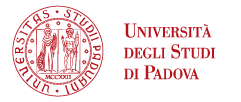Laura Acquasaliente
PhD, Assistant Professor Biochemistry
Department of Pharmaceutical and Pharmacological Sciences, University of Padova
via Marzolo 5, 35131 Padova -IT
Current Position: Assistant Professor (RTD-B) SSD Biochemistry Bio/10
Teaching: Production and Characterization of Therapeutic Proteins; Protein Engeneering
Contacts: phone +39 0498275703; email laura.acquasaliente@unipd.it
Short Cv
2019 - : Researcher (RTDA/B), Dept. of Pharmaceutical & Pharmacological Sciences., University of Padova (Italy)
2017-19: Post-Doctoral Fellow, Dept. of Biochemistry & Molecular Biology, E. Doisy Medical Center, St. Louis University (USA)
2014-16: Post-Doctoral Fellow, Dept. of Chemical Sciences and Dept. of Pharmaceutical & Pharmacological Sciences., University of Padova (Italy)
2014: PhD in Molecular Sciences – curriculum Pharmaceutical Sciences, University of Padova (Italy)
2010: Degree cum laude in Pharmaceutical Chemistry and Technology, University of Padova (Italy)
Dr. Acquasaliente joined the DSF in the Biochemistry Unit in April, 2019.
She pursued a master’s degree in Pharmaceutical Chemistry and Technology in 2010, with 110/110 cum laude, at the University of Padua.
Her PhD was obtained in Biochemistry and Molecular Sciences, at the University of Padua, defending a Thesis entitled: “Discovering Novel Interactions of Thrombin".
She started the post-doctoaral formation at Padua, funded by the Excellence Research Project of the CaRiPaRo, and then concluded at the Saint Louis University (Missouri, USA).
During these years, Dr Acquasaliente has mastered a wide range of experimental techniques in basic molecular biology, protein chemistry, enzyme biochemistry, immunochemistry, and biophysical chemistry. She has actively worked in medical research, focusing on discovering novel physiological interactions of coagulation proteins with relevant target ligand. This gave her the advantage to work in top class laboratories in academia under the direction of exceptional scientists: Proff. De Filippis (Padova), Di Cera (St. Louis), De Cristofaro (Roma), Pengo (Padova), Peyvandi (Milano), and Vasiley (S. Pietroburgo).
Teaching
Office hours
Please contact via email for appointment
Research
Scientific Activities
The main topic is understanding the pathophysiological mechanisms that lead to many life-threatening disorders such as thrombosis, immunothrombosis, cancer and neurodegeneration, using a unique combination of structural biology, protein engineering, enzymology, biochemical and biophysical techniques.
Technical expertise
- Protein Chemistry Techniques: solid-phase peptide synthesis; chemical modification of proteins.
- Analytical Techniques: protein purification; chromatographic and electrophoretic techniques; mass spectrometry (LC-MS/MS); identification of post-translational modifications by peptide mass fingerprint analysis.
- Spectroscopic Techniques: UV-Vis absorption, circular dichroism, and fluorescence spectroscopy; Dynamic Light Scattering (DLS); basic Small-Angle X-ray scattering (SAXS)
- Molecular Recognition: Surface Plasmon Resonance (SPR); Isothermal Titration Calorimetry (ITC); Differential Scanning Calorimetry (DSC)
- Enzyme Kinetics: determination of enzyme kinetic constants under steady-state and rapid conditions (stopped flow); determination of enzyme inhibition constants.
- Molecular Biology techniques: protein expression in mammalian cells, yeast and E.coli; plasmin-DNA purification; site-directed mutagenesis.
- Practical Haemostasis Techniques: determination of clinical coagulation parameters (TT, PT, aPTT, SCT); fibrin generation; platelet agglutination by turbidimetric and impedance aggregometry; multimer size distribution of von Willebrand Factor by agarose gel-electrophoresis.
- Bioinformatics: data analysis software (Origin 8.0, SigmaPlot); interrogation of databases for protein identification and characterization (EXPASY, MASCOT); molecular visualization and modelling software (ViewerPro, PyMol, HyperChem, Chimera, MOE); molecular docking software (HEX, ClusPro); protein structure analysis software (BLUUES, APBS).
- Protein Structure Techniques: robot-automated crystallization; micro-scale crystallization techniques (hanging drop and sitting drop); basic knowledge of NMR (Nuclear Magnetic Resonance); HDX Mass Spectrometry.
Publications
Most Relevant Papers:
- Acquasaliente, L.^#, De Filippis, V. The Role of Proteolysis in Amyloidosis. International Journal of Molecular Sciences 2023, 24, 699. doi: 10.3390/ijms24010699 IF 6.208
- Acquasaliente, L.^, Pontarollo G.^, Radu, C.M., Peterle, D., Artusi, I., Pagotto, A., Uliana, F., Negro, A., Simioni, P., De Filippis, V. Exogenous human a-synuclein acts in vitro as a mild platelet antiaggregant inhibiting a-thrombin-induced platelet activation. Scientific Reports 2022, 12, 9880. doi.org/10.1038/s41598-022-12886-y. IF 4.996
- Scapin, G., Gasparotto, M., Peterle, D., Tescari, S., Porcellato, E., Piovesan, A., Righetto, I., Acquasaliente. L.#, De Filippis, V., Filippini, F. A conserved Neurite Outgrowth and Guidance motif with biomimetic potential in neuronal Cell Adhesion Molecules. Computational and Structural Biotechnology Journal. 2021, 19:5622-5636, doi: 10.1016/j.csbj.2021.10.005. IF 6.155
- Acquasaliente, L.^, Dal Lin, C.^, Iliceto, S. De Filippis, V.; Vitiello, G.; Tona, F. Von Willebrand Factor Multimers and the Relaxation Response: A One-Year Study. Entropy 2021, 23, 447, doi: 10.3390/e23040447. IF 2.738
- Uliana, F.^; Vizovišek, M.^; Acquasaliente, L.; Ciuffa, R.; Fossati, A.; Frommelt, F.; Goetze, S.; Wollscheid, B.; Gstaiger, M.; De Filippis, V.; Auf dem Keller, U., Aebersold, R.Mapping specificity, cleavage entropy, allosteric changes and substrates of blood proteases in a high-throughput screen. Nature Communication 2021, 12, 1693, doi:10.1038/s41467-021-21754-8. IF 17.694
- Acquasaliente, L.^; Pelc, L.A.; Di Cera, E. Probing prothrombin structure by limited proteolysis. Scientidic Reports 2019, 9, 6125, doi:10.1038/s41598-019-42524-z. IF 4.996
- Chakraborty, P.; Acquasaliente, L.; Pelc, L.A.; Di Cera, E. Interplay between conformational selection and zymogen activation. Scientific Reports 2018, 8, 4080, doi:10.1038/s41598-018-21728-9. IF 4.996
- V. De Filippis, L. Acquasaliente, G. Pontarollo, D. Peterle. Noncoded amino acids in protein engineering: Structure-activity relationship studies of hirudin-thrombin interaction. Biotechnology and Applied Biochemistry 2018. 65(1) 69-80. doi: 10.1002/bab.1632. IF 2.724
- Acquasaliente, L.^; Peterle, D.; Tescari, S.; Pozzi, N.; Pengo, V.; De Filippis, V. Molecular mapping of alpha-thrombin (alphaT)/beta2-glycoprotein I (beta2GpI) interaction reveals how beta2GpI affects alphaT functions. Biochemical Journal 2016, 473, 4629-4650, doi:10.1042/bcj20160603. IF 3.766
- Pozzi, N.; Zerbetto, M.; Acquasaliente, L.; Tescari, S.; Frezzato, D.; Polimeno, A.; Gohara, D.W.; Di Cera, E.; De Filippis, V. Loop Electrostatics Asymmetry Modulates the Preexisting Conformational Equilibrium in Thrombin. Biochemistry 2016, 55, 3984-3994, doi:10.1021/acs.biochem.6b00385. IF 3.321
- Vecellio Reane, D.; Vallese, F.; Checchetto, V.; Acquasaliente, L.; Butera, G.; De Filippis, V.; Szabo, I.; Zanotti, G.; Rizzuto, R.; Raffaello, A. A MICU1 Splice Variant Confers High Sensitivity to the Mitochondrial Ca(2+) Uptake Machinery of Skeletal Muscle. Molecular Cell 2016, 64, 760-773, doi:10.1016/j.molcel.2016.10.001. IF 19.328
- Acquasaliente, L.^; Sokolov, A.V.^; Kostevich, V.A.; Frasson, R.; Zakharova, E.T.; Pontarollo, G.; Vasilyev, V.B.; De Filippis, V. Thrombin inhibits the anti-myeloperoxidase and ferroxidase functions of ceruloplasmin: relevance in rheumatoid arthritis. Free Radical Biology & Medicine 2015, 86, 279-294, doi:10.1016/j.freeradbiomed.2015.05.016. IF 8.101
- Acquasaliente, L.^; Pozzi, N.^; Frasson, R.; Cristiani, A.; Moro, S.; Banzato, A.; Pengo, V.; Scaglione, G.L.; Arcovito, A.; De Cristofaro, R.; De Filippis, V.. beta2 -Glycoprotein I binds to thrombin and selectively inhibits the enzyme procoagulant functions. Journal of Thrombosis and Haemostasis 2013, 11, 1093-1102, doi:10.1111/jth.12238. IF 16.036
^ equal contribution; # corresponding author
Complete list of publications
https://www.research.unipd.it/simple-search?query=Acquasaliente
Research projects and Funds
- 2023-24: PRID 2022 (Partecipant) Project “Interplay between a-synuclein, lipid membrane and an amyloid inhibitor: a tripartite system against the progression of Parkinson disease (InterPD)” Università degli Studi di Padova
- 2022-24: PRID 2021 (Unit Coordinator) Project “Development of small Molecules for the EGFR-ECD Targeting (MEETs): a new strategy for the early in vivo diagnosis of EGFR-overexpressing cancers” Università degli Studi di Padova
- 2020-22: PRID-J 2019 (Principal Investigator) Project “Neuro-coagulopathy: role of factor XIIIa in neurodegeneration” Università degli Studi di Padova
- 2020-23: Excellence Research Project CaRiPaRo-2019 (Participant) Project “The role of bacterial proteases in thrombosis and amyloidosis (BipiTA)” Fonadazione CaRiPaRo
- 2017-19: R01 NIH Grant (Participant) Project “Structural determinants of prothrombin activation” Agency National Institute of Health, USA
- 2015: PRAT (Participant) Project “Mass Spectrometry Analysis of Chemical Modifications of Proteins Involved in Thrombotic and Rheumatic Diseases” Università degli Studi di Padova
- 2015: EU Framework Programme-BioStruct-X: n. 283570 (Participant) Project “A new player in the modulation of protein function: the biological membranes”
- 2012-14: Excellence Research Project CaRiPaRo-2011 (Participant) Project “Modeling and Monitoring Motions in Proteins: Cardiovascular diseases at molecular level (M3PC)” Fondazione CaRiPaRo






